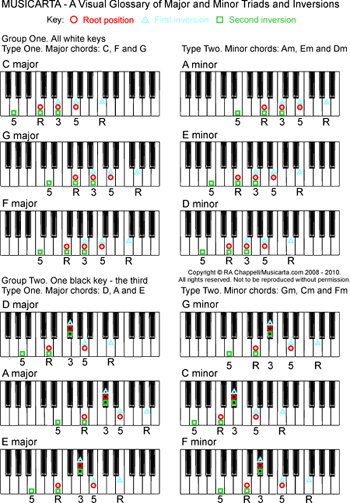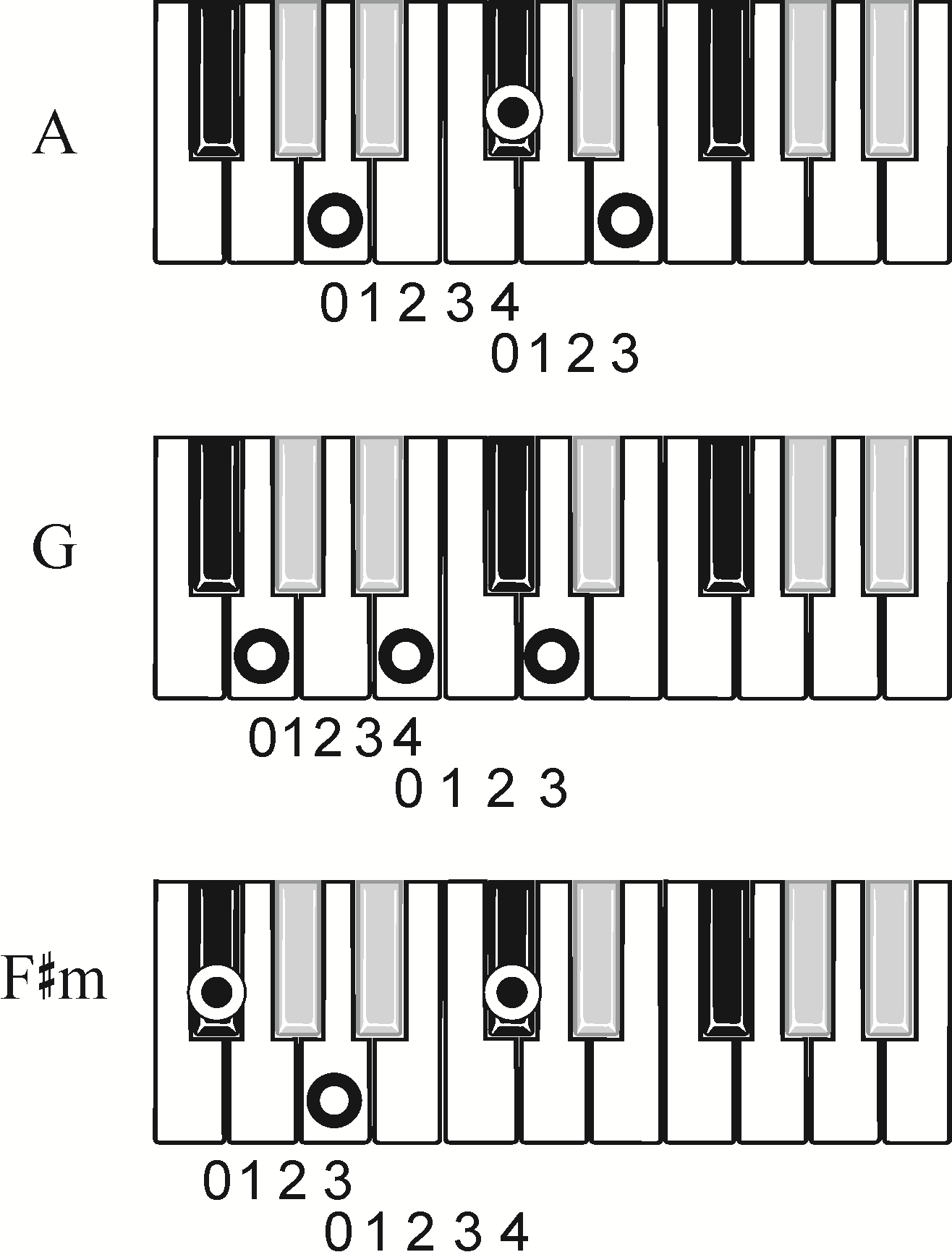Patreon MUSICARTA Premium
HOME CHORDS 101 PAGE
The Musicarta Patreon Chords webpage is your portal to all things chordal.
Every modern keyboard player should be able to find and play chords as easily as a guitarist, and be capable of supporting a melody with the right inversions and
playing an accompaniment from chord symbols.
This Musicarta Patreon chords page acts as an index to your exclusive chords material. Browse the right-hand navigation or use the links in the index text below to start finding out how Musicarta can help you find and play chords the chords you need.
The Musicarta Keyboard Chord Generator
The Musicarta Keyboard Chord Generator is a two-page visual chord dictionary which groups the 24 major and minor triads according to how they look in terms of the black and white keys used.

This new approach helps fast-track you to ‘seeing’ the chords you need right there in the keyboard. Click through to the Musicarta Keyboard Chord Generator page for an explanation and ways of getting the most out of this great tool - plus your Patreon Premium download link.
Major and Minor Chords
|
This one-page standalone module gives you an in-a-nutshell audio explanation of major and minor triads. Keyboard musicians who aim to be able to ‘just sit down and play’ need to know this material inside out. You will find this module a good opportunity to refresh and consolidate your knowledge. Click through here to the Major and Minor Chords module. |
 |
Inversions
Even the most basic chords appears in three guises! They can be turned upside down ('inverted') so any of its three notes is at the top.
In popular music, the keyboard player often plays the melody note at the top of a three-note right hand chord (triad). These chords are more likely to be inversions then the basic easy-to-recognize root position chord - the other inversions are nicer on the ear.
So you need to be able to make inversions from the easy-to-find root position chord, or from a chord symbol, on demand.
Here's a demonstration video of one of the Musicarta inversions drills in this series of pages.
Click through to the first module in the Patreon Musicarta Inversions mini-series and discover the most efficient way to work towards lightning-fast triad mastery.
Triad shapes drill
There are three simple triad shapes – root position, first inversion and second inversion.
A good modern-styles musician, playing in a particular key, will be able to quickly get his/her fingers to any of these three shapes using that key’s scale tones and built either up or down from any note.
The triad shapes drill is the kind of exercise you would use to make sure you can do that. The challenge, initially, is simply to keep going, but when you come to play the drill in the sharp and flat keys, it becomes much more about knowing your keys, and navigating the black keys.
(Here's where your Key Keyboards diagrams might prove useful!)
Anybody
who aspires to ‘just sit down and play’ should work through this drill a
few times in all keys, and come back for a refresher from time to time.
It's a great drill for when you only have a few minutes to practice -
or simply renew your acquaintance with your keyboard!
Keys do feel different under the fingers, and you get to know them. With enough work, you will hear the notes before you play them – the foundation of all playing by ear. Click through here to access your Patreon Premium Triad Shapes Drill page.
Suspensions
An attractive and unmistakable component of a thousand pop hits, suspensions are a great way of getting more out of your chords.
Find out just how - in practice and theory - in the new Musicarta Patreon Suspensions page series.
Here's a rocking piano solo which uses suspensions intensively.
Make suspensions your focus for a week/month or two, and your creative music-making is bound to take a great leap forward.
Seventh Chords
Seventh chords make music sound interesting - jazz and all sophisticated popular music uses them a lot. Whether you’re interested in music theory or not, you need to be able to find the five types of seventh chord from chord symbols, 'just like that'.
Seventh chords easy to learn them if you're methodical. Musicarta's Seventh Chords Patreon Premium page offers a drill which will set you on the right track.
Here's a sample of the practical learning you'll be doing.
Click through to the Seventh Chords page and make a start on those seventh chords right away.
Broken Chords
Broken chord patterns are where you practice your inversions. Your right hand climbs up and down the keyboard getting the feel of the inversions while your ear absorbs their sound.
Time spent practising broken chords is never wasted. Traditional piano lessons usually cover broken chord patterns but only as an exam requirement, and without really exploring how close broken chord pattern are to 'real music'.
Here's a broken chord study that will 'make learning fun' - no kidding!
Don't panic! Click through to the Patreon Premium Broken Chords page for a much gentler introduction and some basic broken chord practice patterns to get started with.
Accompaniment Practice Patterns
Most pieces of music have a musical ‘background’ which supports the melody. In solo keyboard styles, the left hand often supplies this supporting texture - which is essentially a broken chord pattern - and the successful modern keyboard player needs to be able to devise these accompaniment patterns, often from chord symbols alone and ‘on the fly’.
Accompaniment patterns can easily be made from the root, the third and the fifth of the chord, but they have to practised until they’re ‘practically automatic’ and carry on coming regardless of what the right hand is playing.
This Musicarta collection of accompaniment practice patterns will show you how to build them and practice them, using the chords of the Pachelbel Canon in D.
Mister Musicarta often says that becoming a really useful musician is more like going to the gym than you might think! Click through to the new Accompaniment Practice Patterns module now, and get in training.
The Roman Numeral System
The Roman numeral system of naming chords takes you to the heart of how music works. It lays bare the mechanics of harmony, since it talks about chords ‘in all keys at once’, or 'in any key'. The Roman numeral system is simple and logical and not too difficult for beginner-to-intermediate pupils.
Because the Roman numeral system designates ‘the chords in any key’, it is central to the business of transposing (changing the key of a piece of music to raise or lower its pitch). You will find Musicarta’s description of the Roman numeral system of naming chords in Part One of the Musicarta Canon Project ‘Transposing’ mini-series.
To help familiarise you with the Roman numeral system (RNS), the Musicarta Chord Progressions series is written using both RNS and conventional chord symbols. Link through for a look at the series here.
This Musicarta Patreon page is your Chords directory web page. Visit regularly to keep up with the latest additions, and keep an eye on your Patreon messaging app for notifications about new posts.
Thanks for visiting MUSICARTA! Come again soon!
|
OUT NOW! |
THE MUSICARTA BEAT & RHYTHM WORKBOOK At last! An effective approach to keyboard rhythm & syncopation skills. Learn more! |
ONLY $24.95! |
PATREON |
The MusicartaA methodical approach to keyboard syncopation for
|
PUBLICATIONS
exciting keyboard
creativity courses
CHORDS 101
WORKBOOK

~HANON~
video course

Musicarta
Patreon
PENTATONICS
WORKBOOK
video course

Creative Keyboard
video course

BEAT AND RHYTHM
WORKBOOK

- Volume 1 -

12-BAR PIANO
STYLES WORKBOOK

MUSICARTA MODES
WORKBOOK

PIANO STYLE

CANON PROJECT
video course

VARIATIONS
video course


- Piano Solo -
video course

- Piano Solo -







 THE LOGO
THE LOGO
